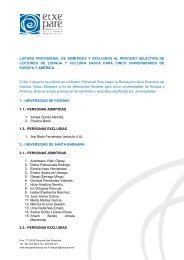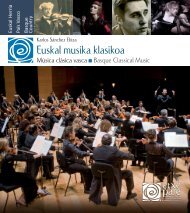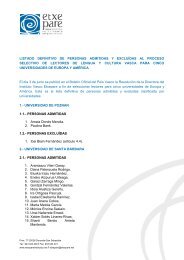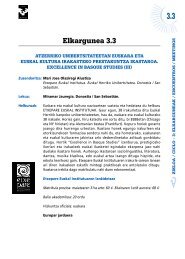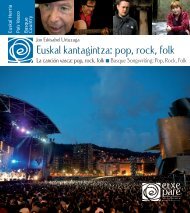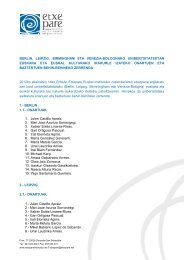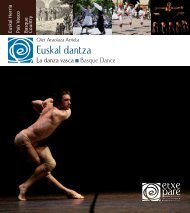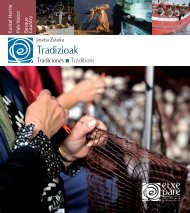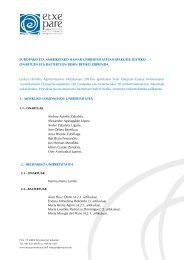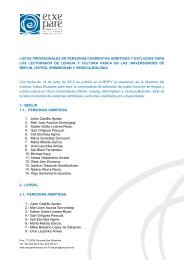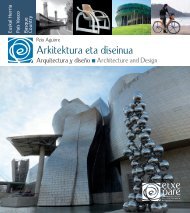Euskal sukaldaritzaz - Etxepare, Euskal Institutua
Euskal sukaldaritzaz - Etxepare, Euskal Institutua
Euskal sukaldaritzaz - Etxepare, Euskal Institutua
You also want an ePaper? Increase the reach of your titles
YUMPU automatically turns print PDFs into web optimized ePapers that Google loves.
Esta cuestión tan constatable en gastronomía, se da<br />
también en las artes: en la música, en la pintura, en<br />
la arquitectura, en la literatura… En todas ellas la memoria<br />
juega un papel esencial, pero la repetición no<br />
es suficiente. ¿Se imagina alguien a un arquitecto,<br />
haciendo siempre la misma excelente casa repetida<br />
que construían sus antecesores? Hace falta salir de<br />
donde se estaba, para volver a ser capaz de conseguir<br />
la intensidad del gozo.<br />
Es por ello que existe otra gran vía para la creación,<br />
también en cocina: lo nuevo, lo original, lo nunca<br />
visto. El cocinero que se considera creador, jamás se<br />
conformará –por excelentes que éstas sean–, con la<br />
repetición y mejora que sacian el alma del cocinero<br />
artesano. Buscará nuevos caminos, a veces incomprendidos,<br />
que requerirán por parte del comensal<br />
algo más que hambre y memoria.<br />
Cuando Bach compuso “Las variaciones de Golberg”<br />
–que tan a gusto escuchamos hoy–, echaba un órdago<br />
a muchos de sus oyentes, que a duras penas<br />
decidían si aquella música tan nueva era realmente<br />
buena. No sabían si les gustaba o no.<br />
Pongamos otro símil: el arquitecto Oscar Niemeyer,<br />
por ejemplo, domina como pocos el ángulo recto,<br />
pero se niega a su utilización y repetición. Prefiere<br />
la curva libre y sensual: «La curva que encuentro<br />
en las montañas de mi país, en la sinuosidad de sus<br />
ríos, en las nubes del cielo y en las olas del mar».<br />
¿Pero qué demonios tendrá que ver una nube con<br />
un edificio?<br />
Ocurre que Niemeyer no es únicamente un artesano<br />
sabio. Claro que domina la artesanía y es muy capaz<br />
de construir en ángulo recto, pero su trabajo implica<br />
bastante más. Con un edificio persigue otros asuntos,<br />
además del de cobijar: «conmoción, emoción,<br />
sorpresa, diferencia y poesía, cosas que no están sujetas<br />
a la escuadra y el cartabón».<br />
De igual manera, hay cocineros con un planteamiento<br />
vital similar. Cocineros que persiguen otros asuntos,<br />
más allá de la mera alimentación y del placer<br />
This obvious issue in gastronomy also exists in the<br />
arts: in music, painting, architecture and literature.<br />
In all thee, memory plays a key role, but repetition is<br />
insufficient. Can anyone imagine an architect always<br />
designing the same house (however excellent), over<br />
and over again, as his predecessors? One must leave<br />
where one was to be able to achieve intense joy once<br />
again.<br />
For this reason there is another creative approach,<br />
and this applies to cooking as well: the new, the original,<br />
the never-before-seen. Chefs who believe themselves<br />
to be artists will never make do –however<br />
excellent they might be– with the repetition and improvement<br />
favoured by artisan chefs. They will seek<br />
new pastures, sometimes inconceivable, that require<br />
of the diner something more than just hunger and<br />
memory.<br />
When Bach composed the “Goldberg Variations”<br />
–which we listen to so happily today– he threw down<br />
the gauntlet to many of his listeners, who had great<br />
difficulty in deciding whether such new music was<br />
really any good. They didn’t know whether they liked<br />
it or not.<br />
Let’s use another comparison: the architect Oscar<br />
Niemeyer, for example, controls the right angle more<br />
than most, but refuses to use and repeat using it.<br />
Instead, he prefers the free and sensual curve, “the<br />
curve that I find in the mountains of my country, in<br />
the sinuous course of its rivers, in the waves of the<br />
sea, in the clouds of the sky”. But what on earth has<br />
a cloud to do with a building?<br />
The fact is that Niemeyer is not just a wise artisan.<br />
Of course he is a master artisan and more than capable<br />
of building a right angle, but his work implies<br />
so much more. He looks for other things in a building<br />
beyond just shelter: “commotion, emotion, surprise,<br />
difference and poetry, things which don’t depend on<br />
the set square”.<br />
Similarly, there are chefs who believe in the same basic<br />
approach; chefs that seek other things, beyond<br />
39



